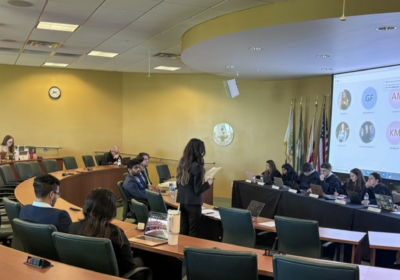Moffitt performs fully robotic Whipple surgery
Surgeries performed by robots were once an idea of science fiction, but areslowly becoming a more common part of public health.
The Moffitt Cancer Center on the USF Tampa campus was the first hospital in the state to conduct a fully robotic Whipple surgery, and has
performed 16 total.
Whipple surgery involves gaining entrance through the abdomen with the goal of removing the head of the pancreas, with some later reconstruction of the intestines. But robotic surgeries offer faster recovery times, less cosmetic scarring and less pain.
When Thomas Whitney, a 61-year-old human resources director from St. Petersburg, Fla. entered the Moffitt Center last fall, he was diagnosed with stage IV pancreatic cancer and given between six to 18 months to live.
Dr. Mokenge Malafa, chair of the department of gastrointestinal oncology, said Whitney was fortunate the tumor had formed in the head of his pancreas allowing Whitney to be among the first eligible for removal through a Whipple surgery.
The Whipple surgery was the only option that could make a difference in this patients specific form of pancreatic cancer, Malafa said.
Whitney, however, said he was initially hesitant about the procedure.
One of my biggest concerns, one that I expressed to Dr. Malafa, was where does the tool come in? he said. Could it just be running through my flesh without any regard for sensitivity? I was definitely weirded out by the robots at first.
Malafa said the process of a robotics surgery isnt as ominous as it sounds.
There is no robot just running free with a scalpel, he said. During the Whipple surgery, I had a co-surgeon and a team of nurses in the room the whole time. Its kind of like playing a videogame. After the small incisions are made for the robot equipment to enter the patients abdomen, I go into another room and perform the surgery through viewing an HD camera. I insert my hands into a controller and perform the operation remotely. I am always in control.
Whitneys surgery, along with many other robotic surgeries, used the da Vinci Surgical System, a system that allows doctors to view the procedure with an HD camera and a robotic hand that is capable of more motion than a human hand.
Whitney said in some ways he was relieved the surgery was robotic.
My surgery was an 18-hour process, Whitney said. I would have probably felt more unsafe if I knew a human being was going to have to be under that kind of pressure for 18 hours.
Malafa said the da Vinci System was previously used for simpler surgeries, such as gall bladder removal, where many of these benefits were seen.
It will be interesting to see if these same benefits remain when doing a more complex surgery such as the Whipple surgery performed on Mr. Whitney, he said.
But Whitney said he believes he has already witnessed the benefits of the minimally invasive robotic surgery.
After the surgery I was only in the hospital for two weeks, but I was able to walk and get around so I think my recovery has been remarkably fast, Whitney said. Considering the extensiveness of the surgery and the recovery time it took, I am really in a lot better shape than I thought I would be. If I had to do it again, I would prefer the robotic surgery.
John D. Petrila, professor in the department of health policy and management, said people should expect public health to move in the direction of more robotic surgeries.
The bottom line is we are still in the early days of this technology, Petrila said. As people get more used to it, we should start to see a rapid expansion of at least partially robotic surgeries.
Malafa said Moffitt is hoping to transform its patient care to the point where more than half of pancreatic operations will be done robotically.
EDITOR’S NOTE:This article has been edited from its original version.






